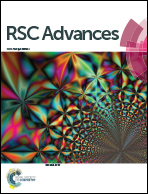Using Raman and dielectric spectroscopy to elucidate the spin phonon and magnetoelectric coupling in DyCrO3 nanoplatelets
Abstract
In this study, we report the phonon-mode assignment of DyCrO3 nanoplatelets by Raman spectroscopy. The temperature dependent Raman studies indicate the shift in the phonon frequency of most intense modes of DyCrO3 and the observed change in Raman line-width is correlated with the spin–phonon coupling. The impedance spectroscopy reveals anomalies in the dielectric constant vs. temperature curve in the proximity of the magnetic transitions, thereby hinting towards possible weak magnetoelectric coupling in DyCrO3 nanoplatelets. For the first time, UV-vis absorption spectroscopy and photocatalytic activity of DyCrO3 nanoplatelets have been reported. The optical absorption spectrum gives the band gap ∼2.8 eV for DyCrO3 nanoplatelets suggesting them as a good candidate for studying photocatalytic activity. The DyCrO3 nanoplatelets showed an efficient photocatalytic activity by degrading 65% methyl orange after 8 h irradiation.


 Please wait while we load your content...
Please wait while we load your content...